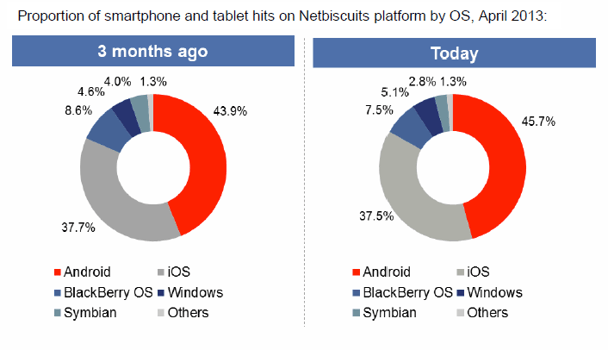Older Devices Dominate Mobile Market

Keeping up with the ever-changing mobile market is difficult, to say the least. A new study, however, reveals that businesses should be paying more attention to older devices rather than new ones, as it takes time for newer devices to become established.
Adaptive mobile Web experience software provider Netbiscuits has launched its latest Quarterly Web Trends Report, which shows that fragmentation is increasing rapidly, with the top-10 mobile devices accounting for only 48 percent of total traffic. Plus, regional variances are also leading to inconsistent experiences for users.
The report, which is based on the Netbiscuits Cloud Platform that handles billions of global Web and content impressions a month, found that older devices actually dominate Web traffic. In fact, the top-used device is Apple's iPhone 4S running iOS 6+, followed by the iPhone 4 also running on iOS 6+, with the Samsung Galaxy S3 running Android 4+ in the third spot. Interestingly, Apple's iPhone 5, which is the newest iPhone that was released in Sept. 2013 and sold more than 5 million units in its first week, did not even make the top-10 devices.
In addition, the report shows that 38 percent of mobile usage came from 3,430 different versions of hardware and software. This robust variation in device and software usage has made it very difficult for brands to build a universal experience to meet the needs of every customer. And a lack of testing across platforms complicates this problem even further.
"One look at the base of current handsets in use shows just how long it takes for legacy devices to be replaced in the market," commented Michael Neidhoefer, CEO, Netbiscuits. "Our research finds that the top, most-used devices for each handset manufacturer are usually older devices. The average lifespan of a device is much longer than many companies think, and although the newest devices do eventually catch up in terms of consumer usage, it would be unwise to abandon testing on 'older' devices because consumers are using them the most. Companies that are only testing their websites on the latest gadgets are actually ignoring the majority of their users and are failing to understand the diversity of devices in the market, the complexity of device adoption and the number of people already accessing the Web through established channels."
Other insights from the study reveal device variations at the regional and country level, showing that there is a significant chance that brands are delivering broken mobile Web experiences to consumers in certain areas. For example, there is a noticeable absence of Android devices in the Australian Top 10 list, while Singapore's Top 10 accounts for 62 percent of all users. Comparatively, Australia's top 10 made up 45 percent of all users.
All that said, the report still shows that Apple occupies the number one position in regard to devices accessing the Netbiscuits platform globally. However, Android is the most popular operating system, accounting for 46 percent of all hits which is an increase from 44 percent that was reported three months ago. It is also important to note that iOS6+ accounts for a third of the global traffic share alone, and 86 percent of all Apple users are on the most recent version of the software. In comparison, the Android market is very fragmented, with 56 percent of users on version 4 and 43 percent on version 2.3+.
"The fragmentation of the Android operating system has been part of its major growth and its open standards are testimony to why Web developers cannot treat Android as a single entity with testing conducted on a handful of devices," concluded Michael Neidhoefer. "Web users today have a huge array of devices to choose from, yet this choice creates a major headache for brands when they think about building for different devices and operating systems. We are experiencing an unprecedented explosion of connected devices and the pressure is now on brands to deliver an adaptive multi-channel universal Web experience accessible by everyone. Deploying server-side Web services or a device database to detect device profiles is fast becoming the best option to help brands successfully implement a winning mobile strategy. Those organizations that succeed at delivering a seamless experience across multiple devices will thrive. Those that don't will cease to be relevant to their customers."










